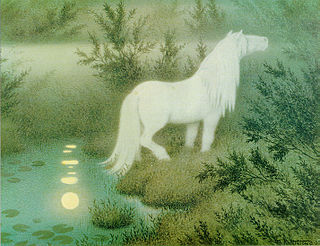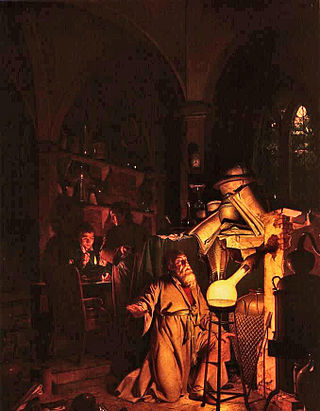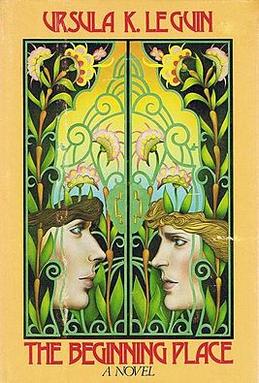High fantasy, or epic fantasy, is a subgenre of fantasy defined by the epic nature of its setting or by the epic stature of its characters, themes, or plot. High fantasy is set in an alternative, fictional ("secondary") world, rather than the "real" or "primary" world. This secondary world is usually internally consistent, but its rules differ from those of the primary world. By contrast, low fantasy is characterized by being set on Earth, the primary or real world, or a rational and familiar fictional world with the inclusion of magical elements.

Michael John Moorcock is an English–American writer, particularly of science fiction and fantasy, who has published a number of well-received literary novels as well as comic thrillers, graphic novels and non-fiction. He has worked as an editor and is also a successful musician. He is best known for his novels about the character Elric of Melniboné, which were a seminal influence on the field of fantasy in the 1960s and 1970s.

Sword and sorcery (S&S) or heroic fantasy is a subgenre of fantasy characterized by sword-wielding heroes engaged in exciting and violent adventures. Elements of romance, magic, and the supernatural are also often present. Unlike works of high fantasy, the tales, though dramatic, focus on personal battles rather than world-endangering matters. Sword and sorcery commonly overlaps with heroic fantasy. The genre originated from the early-1930s works of Robert E. Howard. The term "sword and sorcery" was coined by Fritz Leiber in the May 1961 issue of the fantasy fanzine Amra, to describe Howard and the stories that were influenced by his works. In parallel with "sword and sorcery", the term "heroic fantasy" is used, although it is a more loosely defined genre.

A fantasy world or fictional world is a world created for fictional media, such as literature, film or games. Typical fantasy worlds feature magical abilities. Some worlds may be a parallel world connected to Earth via magical portals or items ; an imaginary universe hidden within ours ; a fictional Earth set in the remote past or future ; an alternative version of our History ; or an entirely independent world set in another part of the universe.

Genre fiction, also known as formula fiction or popular fiction, is a term used in the book-trade for fictional works written with the intent of fitting into a specific literary genre in order to appeal to readers and fans already familiar with that genre.

Brian David Sibley is an English writer. He is author of over 100 hours of radio drama and has written and presented hundreds of radio documentaries, features and weekly programmes. He is widely known as the author of many film "making of" books, including those for the Harry Potter series and The Lord of the Rings and The Hobbit trilogies.

Eric Rücker Eddison, CB, CMG was an English civil servant and author, writing epic fantasy novels under the name E. R. Eddison. His best-known works include The Worm Ouroboros (1922) and the Zimiamvian Trilogy (1935–1958).

Historical fantasy is a category of fantasy and genre of historical fiction that incorporates fantastic elements into a more "realistic" narrative. There is much crossover with other subgenres of fantasy; those classed as Arthurian, Celtic, or Dark Ages could just as easily be placed in historical fantasy. Stories fitting this classification generally take place prior to the 20th century.

Fantasy literature is literature set in an imaginary universe, often but not always without any locations, events, or people from the real world. Magic, the supernatural and magical creatures are common in many of these imaginary worlds. Fantasy literature may be directed at both children and adults.

Elements of the supernatural and the fantastic were an element of literature from its beginning. The modern genre is distinguished from tales and folklore which contain fantastic elements, first by the acknowledged fictitious nature of the work, and second by the naming of an author. Works in which the marvels were not necessarily believed, or only half-believed, such as the European romances of chivalry and the tales of the Arabian Nights, slowly evolved into works with such traits. Authors like George MacDonald (1824–1905) created the first explicitly fantastic works.

Mythago Wood is a fantasy novel by British writer Robert Holdstock, published in the United Kingdom in 1984. Mythago Wood is set in Herefordshire, England, in and around a stand of ancient woodland, known as Ryhope Wood. The story involves the internally estranged members of the Huxley family, particularly Stephen Huxley, and his experiences with the enigmatic forest and its magical inhabitants. The conception began as a short story written for the 1979 Milford Writer's Workshop; a novella of the same name appeared in the September 1981 edition of The Magazine of Fantasy & Science Fiction.

The Broken Sword is a fantasy novel by American writer Poul Anderson, originally published on 5 November 1954. It was issued in a revised edition by Ballantine Books as the twenty-fourth volume of their Ballantine Adult Fantasy series in January 1971. The original text was returned to print by Gollancz in 2002. The novel is set during the Viking Age and the story contains many references to the Norse mythology.

Kingdoms of Sorcery: An Anthology of Adult Fantasy is an anthology of fantasy stories, edited by American writer Lin Carter. It was first published in hardcover by Doubleday in January 1976 as the first of two such anthologies continuing a series of nine assembled by Carter for the Ballantine Adult Fantasy series.

Elements of the supernatural and the fantastic were an element of literature from its beginning, though the idea of a distinct genre, in the modern sense, is less than two centuries old.

The Beginning Place is a short novel by American writer Ursula K. Le Guin, written in 1980. It was subsequently published under the title Threshold in 1986. The story's genre is a mixture of realism and fantasy literature. The novel's epigraph "What river is this through which the Ganges flows?" is quoted from Jorge Luis Borges. The novel has been subject to critical studies comparing it to C.S. Lewis' The Chronicles of Narnia, Lewis Carroll's Through the Looking-Glass and William Shakespeare's As You Like It.
J. R. R. Tolkien's bestselling fantasy novel The Lord of the Rings had an initial mixed literary reception. Despite some enthusiastic early reviews from supporters such as W. H. Auden, Iris Murdoch, and C. S. Lewis, literary hostility to Tolkien quickly became acute and continued until the start of the 21st century. From 1982, Tolkien scholars such as Tom Shippey and Verlyn Flieger began to roll back the hostility, defending Tolkien, rebutting the critics' attacks and analysing what they saw as good qualities in Tolkien's writing.
This is a bibliography of the works of Michael Moorcock.

The following outline is provided as an overview of and topical guide to fantasy:
Wizardry and Wild Romance: A Study of Epic Fantasy is a book by Michael Moorcock published in 1987.
J. R. R. Tolkien, the author of the bestselling fantasy The Lord of the Rings, was largely rejected by the literary establishment during his lifetime, but has since been accepted into the literary canon, if not as a modernist then certainly as a modern writer responding to his times. He fought in the First World War, and saw the rural England that he loved built over and industrialised. His Middle-earth fantasy writings, consisting largely of a legendarium which was not published until after his death, embodied his realism about the century's traumatic events, and his Christian hope.














